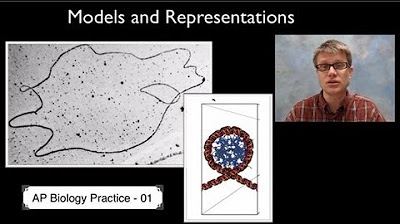AP Biology Practice 4 - Data Collection Strategies
Summary
TLDRIn this AP Biology Science Practice video, Mr. Andersen discusses the importance of data collection in scientific inquiry, emphasizing the scientific method's role alongside observational and historical sciences. He illustrates the process with an example of an enzyme experiment and explains the significance of controlling variables. The video also covers how to justify data collection strategies, design experiments, collect specific data to answer questions, and evaluate given data, using examples from evolution, free energy, information, and systems.
Takeaways
- 🌟 Science is fundamentally about asking questions and gathering data to understand the objective reality governed by natural laws.
- 🏀 The scientific method is a powerful tool in science, but it's not the only approach; observational and historical sciences are also important.
- 🔍 In designing a controlled experiment, it's crucial to identify the independent and dependent variables and control other variables to ensure valid data collection.
- 🌡 An example of an experiment is measuring the effect of temperature on enzyme activity using catalase, where temperature is the independent variable and enzyme action speed is the dependent variable.
- 🧪 Control variables in an experiment should be carefully considered to maintain consistency, such as pH and solution concentration.
- 📊 College Board expects students to understand data collection in the context of the four big ideas of AP Biology: evolution, free energy, information, and systems.
- 🐟 An example of data collection in evolution could be measuring changes in stickleback fish pelvis length over time as they adapt to different environments.
- 🌱 Data related to nutrient cycling, such as nitrogen levels, could be collected to understand free energy in ecosystems.
- 🔬 Historical data, like Fredrick Griffith's experiment on bacterial transformation, is valuable for understanding information in biology.
- 🧬 To determine if two plant species are the same, one could collect data on their ability to interbreed, DNA sequences, or chromosome numbers.
- 🔴 The Hershey-Chase experiment used radioactive sulfur and phosphorus to differentiate between protein and DNA, leading to the discovery that DNA is the genetic material.
Q & A
What inspired Mr. Andersen when he was young, and how has that changed over time?
-When Mr. Andersen was young, he was inspired by Michael Jordan and had posters of him everywhere. However, today he is more inspired by academics rather than athletic achievements.
What ties together the scientists mentioned in the video?
-The scientists mentioned in the video, including Darwin, Mendel, Louis Pasteur, E.O. Wilson, and Jane Goodall, are tied together by their ability to ask questions and gather data to answer those questions, which is a fundamental aspect of science.
What is science according to Mr. Andersen?
-According to Mr. Andersen, science is the belief in an objective shared reality that is governed by natural laws. These laws can be discovered through observation and experimentation.
What are the different types of science mentioned, and how do they differ?
-The different types of science mentioned are the scientific method, observational science, and historical science. The scientific method is a powerful tool involving controlled experiments, observational science involves gathering data through observation, and historical science looks at data collected over time.
In the enzyme activity experiment described, what are the independent and dependent variables?
-In the enzyme activity experiment, the independent variable is the temperature of the enzyme, and the dependent variable is how fast the enzyme acts.
Why is controlling variables important in an experiment, and how is this achieved in the classroom?
-Controlling variables is important to ensure that the data collected is valid. In the classroom, students are asked to come up with about ten control variables to ensure consistency in the experiment, such as maintaining the same pH, concentration of solutions, and using fresh hydrogen peroxide each time.
What example does Mr. Andersen use to illustrate the concept of evolution and data collection?
-Mr. Andersen uses the example of the stickleback fish in the glacial lakes of Alaska, which quickly adapt to their local environment. He suggests measuring their pelvis length over time as they move from areas with many predators to areas with fewer predators to observe evolution.
How does Mr. Andersen suggest students approach a question involving data collection strategies?
-Mr. Andersen suggests that students should first identify the data collection strategies, justify them, and then design a plan for collecting their own data. He emphasizes the importance of identifying independent and dependent variables, discussing the procedure, and considering statistical analysis.
What approach does Mr. Andersen recommend for designing an experiment, and what should students focus on?
-Mr. Andersen recommends that students should identify the independent and dependent variables, briefly discuss the procedure, consider statistical analysis, and include multiple trials. He emphasizes that students should focus on thoroughly formulating how they would conduct the experiment.
What is the significance of the Hershey-Chase experiment, and why were specific isotopes used?
-The Hershey-Chase experiment was significant because it identified DNA as the transforming factor in genetics. Radioactive sulfur and phosphorus were used because phosphorus is found in DNA, while sulfur is found in protein. This helped distinguish which molecule was responsible for the genetic transformation.
Outlines

This section is available to paid users only. Please upgrade to access this part.
Upgrade NowMindmap

This section is available to paid users only. Please upgrade to access this part.
Upgrade NowKeywords

This section is available to paid users only. Please upgrade to access this part.
Upgrade NowHighlights

This section is available to paid users only. Please upgrade to access this part.
Upgrade NowTranscripts

This section is available to paid users only. Please upgrade to access this part.
Upgrade NowBrowse More Related Video

AP Biology Science Practice 1: Models and Representations

AP Biology Practice 7 - Connecting Knowledge

AP Biology Practice 3 - Formulate Questions

AP Biology Practice 6 - Scientific Explanations and Theories

AP Biology Practice 2 - Using Mathematics Appropriately

AP Biology Practice 5 - Analyze Data and Evaluate Evidence
5.0 / 5 (0 votes)